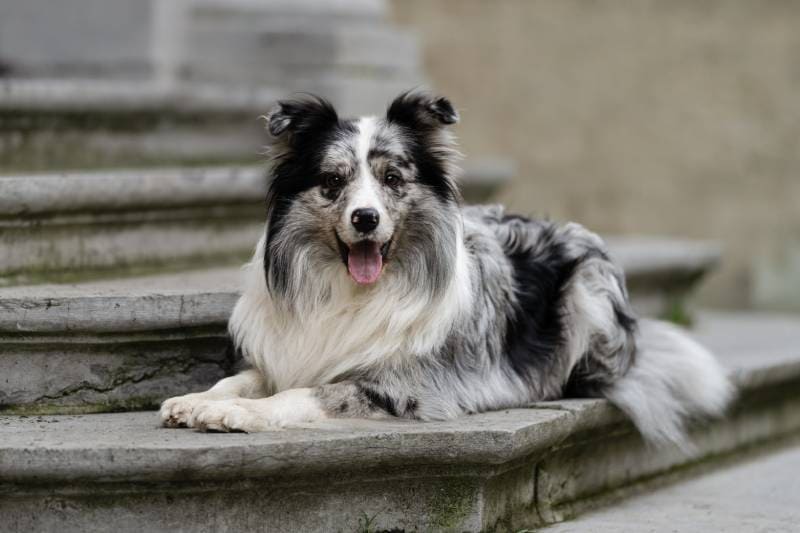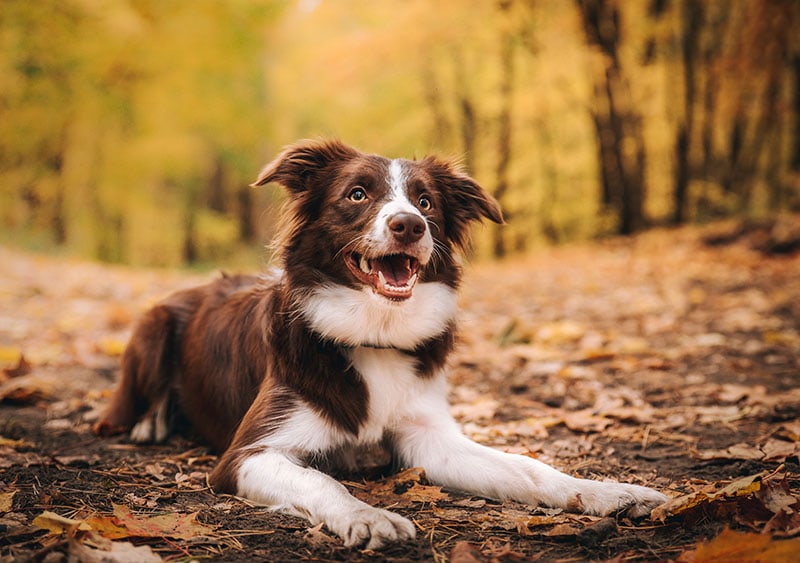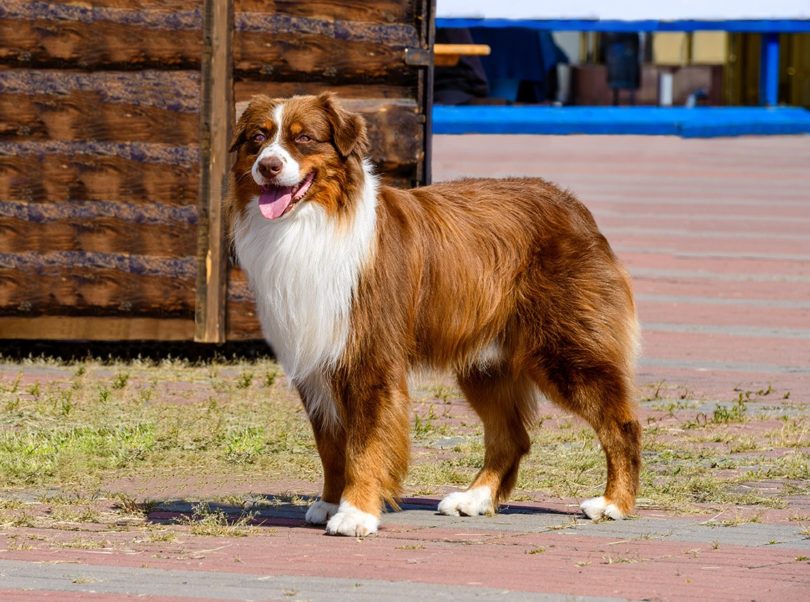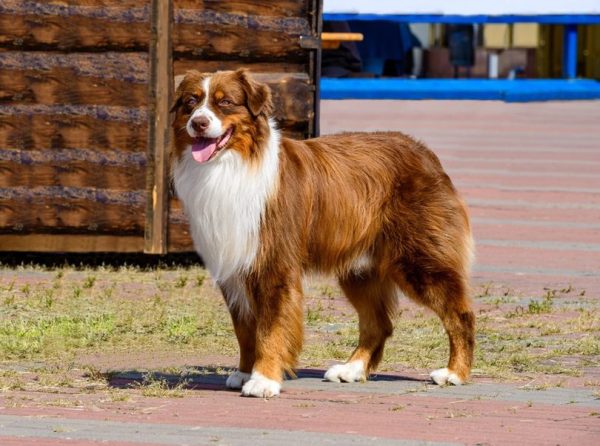Border Collies are intelligent, high-energy, and adorable dogs. And thanks to their distinctive color combinations, many people can spot a Border Collie at first glance.
Though black and white is the most common color, Border Collies come in a wide variety of standard color combinations in both smooth and rough coats. Let’s take a look at the most common color combinations.
The 20 Border Collie Colors & Patterns
1. Black and White
Undoubtedly the most common coat color for Border Collies is black and white, the iconic color combination that most people associate with this breed and the one that expresses most often. These dogs typically have a black body with white markings on their face and belly.

2. Black
Black is a rare color in Border Collies, but it does occur sometimes. Also, a black Border Collie may have white markings—which is different from a black and white Border Collie—in small patches on their chest, tail, legs, and face.

3. Black Tri-Color
Black tri-color Border Collies have black bodies with white markings, but they have touches of tan on their chest, tail, legs, and cheeks. These dogs often have tan eyebrows as well. The gene for this color expression is recessive, so both parents have to have it to produce tri-color puppies.

4. Blue and White
This is where Border Collie genes get interesting! Blue and white Border Collies are black and white genetically, but their color genes are diluted to turn the rich black into more of a bluish-gray. Both parents must carry this gene to create a blue and white pup.
5. Blue Merle
Merle colorations are popular because they’re particularly striking. With a blue merle, the dog has a faded gray color with black or blue patches. This gene is a dominant modifying gene that creates the same color all over the dog’s body, and just one parent needs to carry it. Dogs with the merle gene typically have light noses and eyes.
The beauty comes with a price, however. If two merle parents are bred, the resulting puppies can suffer from blindness or deafness.

6. Blue Tri-Color
The blue tri-color pattern has a solid base coat with tan or copper markings on the dog’s face, chest, back, and eyebrows. This coat color comes from the dominant merle gene and two of the tri-color gene.
7. Red
Red is a collective color that includes many shades of red, ranging from a golden red to a dark auburn. This color comes from a recessive gene, so it requires two copies from parents.

8. Red Merle
Red Merle Border Collies have the merle pattern of a red base coat with white and darker markings. This is a rarer expression of the merle gene. The pups are more likely to have light eyes, noses, and paws, as well as potential health problems from the merle gene.
9. Gold
Gold is a unique and rare color for Border Collies. They tend to look more like Golden Retrievers due to the dilution of their red coats. They can range from light gold to deep gold but the coloration comes from a recessive gene.
10. Chocolate and White
The chocolate color for Border Collies comes from a recessive gene and requires both parents, which makes it a bit rarer. These dogs can have a light brown to a deep, rich chocolate brown with white markings on their face, chest, and collar, as well as yellow-gold eyes.

11. Chocolate Tri-Color
Chocolate tri-color Border Collies combine the unique beauty of the chocolate color with tan or copy and white. Both parents must have a recessive gene for both chocolate and tri-color expression.
12. Lilac
The lilac coat color is not quite lilac purple but more of a blue-gray with a warm brown. These coat colors are unique in that they shift in different light, leading to the lilac appearance. The parents of these pups must have the recessive chocolate and the dilute gene, so they’re quite rare.
13. Lilac Merle
The lilac merle gene creates a patch pattern with solid color and dilute markings that give a blue-purple appearance. Some lilac merle Border Collies have tan points, but the parents must have two recessive tan genes and the genes for lilac and merle.
14. Brindle
Brindle Border Collies may have a base coat in any color with small tiger stripes to be a brindle. These dogs have a similar look to Merle, but instead of spots or patches, they have streaks or stripes.
15. Sable
The sable color is a mix of light roots with hair that’s darker at the tip. They’re generally not dark, as the combination of light and dark makes them look more like a gray or light red or tan color. Some sable coloration includes white markings.
16. Seal
The seal color is an incomplete expression of the sable gene, which gives the dog a dark brown or black color that resembles a seal. In some cases, the seal color has lighter patches, but not always.
https://www.instagram.com/p/CrYmZ4FoS49/?utm_source=ig_web_copy_link
17. Slate Merle
Slate Merle Border Collies have a lighter shade of blue merle and share similar genes. But unlike true blue merles, slate merles will have a solid black nose instead of gray.
18. Piebald
Piebald dogs have a solid white color with asymmetrical spots all over the body. Usually, the head is darker or a solid color, while the body has colored spots in black, red, or blue with a lot of white space. Dogs that have mostly white heads may be more prone to deafness.
19. White Ticked
A white-ticked Border Collie has a two-color coat, but the white areas have small black specks. Though it’s not for everyone, white-ticked Border Collies are considered a standard color for most kennel clubs.
20. Saddleback Sable
Saddleback sable dogs look a lot like sable or sable tri-color dogs, but they have a distinct “saddle” on their back separated by large white areas. These dogs may have some tan on their face.
Do Kennel Clubs Recognize Different Border Collie Colors?
The different kennel clubs recognize different colors in Border Collies. American Kennel Club recognizes 17 different standard colors for this breed: Black, blue, blue merle, brindle, gold, red, lilac, red merle, sable, sable merle, white and black, saddleback sable, white and blue, white and blue merle, white and red, white and red merle, and white ticked.
The Canadian Kennel Club recognizes virtually all Border Collie colors, as long as white is not the dominant coat color.
The United Kennel Club considers black and red the most common colors but recognizes blue merle, red merle, lemon, sable, and gray. Border Collies are only permitted to have white trim and tan points.
Final Thoughts
The black and white Border Collie may be the most common of all Border Collies, but these dogs come in a wide variety of colors and patterns that are within the breed standard for major kennel clubs.
Featured Image Credit: volofin, Shutterstock
Contents
- The 20 Border Collie Colors & Patterns
- 1. Black and White
- 2. Black
- 3. Black Tri-Color
- 4. Blue and White
- 5. Blue Merle
- 6. Blue Tri-Color
- 7. Red
- 8. Red Merle
- 9. Gold
- 10. Chocolate and White
- 11. Chocolate Tri-Color
- 12. Lilac
- 13. Lilac Merle
- 14. Brindle
- 15. Sable
- 16. Seal
- 17. Slate Merle
- 18. Piebald
- 19. White Ticked
- 20. Saddleback Sable
- Do Kennel Clubs Recognize Different Border Collie Colors?
- Final Thoughts












